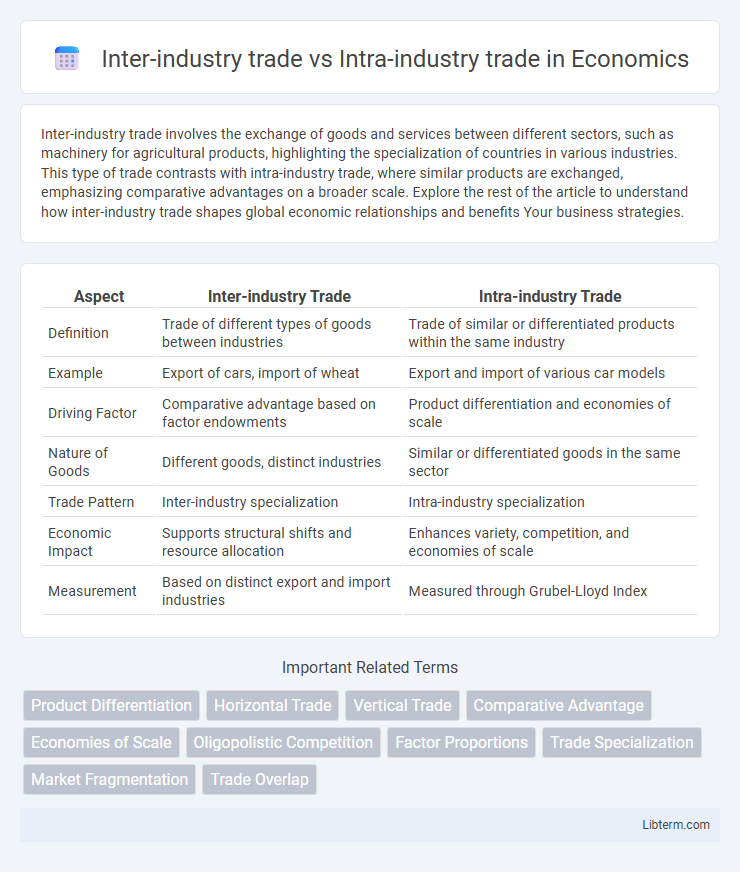Inter-industry trade involves the exchange of goods and services between different sectors, such as machinery for agricultural products, highlighting the specialization of countries in various industries. This type of trade contrasts with intra-industry trade, where similar products are exchanged, emphasizing comparative advantages on a broader scale. Explore the rest of the article to understand how inter-industry trade shapes global economic relationships and benefits Your business strategies.
Table of Comparison
| Aspect | Inter-industry Trade | Intra-industry Trade |
|---|---|---|
| Definition | Trade of different types of goods between industries | Trade of similar or differentiated products within the same industry |
| Example | Export of cars, import of wheat | Export and import of various car models |
| Driving Factor | Comparative advantage based on factor endowments | Product differentiation and economies of scale |
| Nature of Goods | Different goods, distinct industries | Similar or differentiated goods in the same sector |
| Trade Pattern | Inter-industry specialization | Intra-industry specialization |
| Economic Impact | Supports structural shifts and resource allocation | Enhances variety, competition, and economies of scale |
| Measurement | Based on distinct export and import industries | Measured through Grubel-Lloyd Index |
Introduction to Inter-industry and Intra-industry Trade
Inter-industry trade involves the exchange of goods and services between different industries, typically reflecting comparative advantage in the production of distinct products such as electronics versus textiles. Intra-industry trade, by contrast, occurs within the same industry and involves trading similar or differentiated products, like cars for cars, driven by factors such as product variety and economies of scale. Understanding these trade patterns is essential for analyzing global trade dynamics and economic specialization.
Defining Inter-industry Trade
Inter-industry trade refers to the exchange of goods and services between countries that belong to different industries or sectors, such as agricultural products traded for manufactured goods. This type of trade typically reflects comparative advantages, where countries specialize in producing goods where they have lower opportunity costs. Inter-industry trade contrasts with intra-industry trade, which involves the exchange of similar products within the same industry.
Explaining Intra-industry Trade
Intra-industry trade refers to the exchange of similar products belonging to the same industry between countries, such as cars for cars or electronics for electronics. It is driven by product differentiation, economies of scale, and consumer preference for variety, allowing countries to specialize in different varieties or models within the same industry. This type of trade enhances market efficiency, maximizes consumer choice, and supports firms in achieving cost reductions through large-scale production.
Key Differences Between Inter-industry and Intra-industry Trade
Inter-industry trade involves the exchange of completely different goods between industries, such as automobiles for textiles, driven by comparative advantage and differences in factor endowments. Intra-industry trade consists of trading similar products within the same industry, like different car models, often explained by economies of scale and product differentiation. Key differences include the nature of goods exchanged, underlying economic theories, and the impact on industry specialization and consumer choice.
Economic Theories Underpinning Each Trade Type
Inter-industry trade is grounded in the classical comparative advantage theory, which explains trade based on differences in factor endowments and productivity across countries, leading to specialization in distinct industries. Intra-industry trade is explained by the New Trade Theory and economies of scale, emphasizing product differentiation and consumer preference for variety within the same industry, resulting in simultaneous import and export of similar goods. The Heckscher-Ohlin model supports inter-industry trade, while models like Krugman's incorporate increasing returns to scale and monopolistic competition to explain intra-industry exchanges.
Major Drivers of Inter-industry Trade
Inter-industry trade is driven primarily by comparative advantage, where countries specialize in producing goods for which they have lower opportunity costs, leading to the exchange of distinctly different products, such as machinery for agricultural products. Factor endowments, technological disparities, and resource distribution create specialization patterns that underpin inter-industry trade flows. Demand differences and transportation costs also influence inter-industry trade by shaping the economic incentives and practical feasibility for countries to exchange dissimilar goods.
Factors Promoting Intra-industry Trade
Economies with similar factor endowments and technology levels tend to engage more in intra-industry trade, driven by product differentiation and consumer preferences for variety. High levels of economic integration, reduced trade barriers, and advanced transportation infrastructure further promote intra-industry trade by lowering transaction costs and enabling specialization. Firms investing in research and development innovate within the same industry, fostering vertical and horizontal differentiation that sustains trade in similar but distinct products.
Benefits and Challenges of Inter-industry Trade
Inter-industry trade, involving the exchange of goods between different industries, boosts economic specialization and enhances comparative advantage by allowing countries to focus on producing goods where they have efficiency. This type of trade promotes resource allocation optimization and market expansion but often faces challenges such as adjustment costs for workers transitioning between industries and trade imbalances. Moreover, inter-industry trade can lead to structural unemployment and income disparities due to shifts in industrial competitiveness.
Advantages and Limitations of Intra-industry Trade
Intra-industry trade enhances product variety and economies of scale by allowing countries to both import and export similar goods, leading to increased consumer choice and efficiency in production. It supports innovation and technology transfer while reducing the impact of trade imbalances between countries with similar economic structures. Limitations include potential adjustment costs for workers in specific industries and the complexity of managing trade policies that support differentiated products within the same sector.
Real-world Examples and Policy Implications
Inter-industry trade occurs when countries exchange goods from different industries, such as oil exports from Saudi Arabia traded for machinery imports from Germany, reflecting comparative advantages in distinct sectors. Intra-industry trade involves exchanging similar products within the same industry, exemplified by automobile trade between the United States and Japan, where variations in models and brands cater to diverse consumer preferences. Policy implications include the need for governments to support specialization and innovation in inter-industry trade while fostering competitive differentiation, product standards, and economies of scale to enhance intra-industry trade benefits.
Inter-industry trade Infographic

 libterm.com
libterm.com